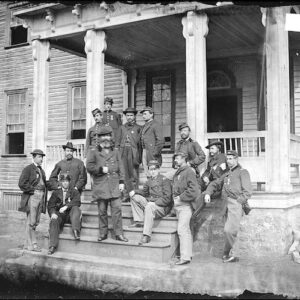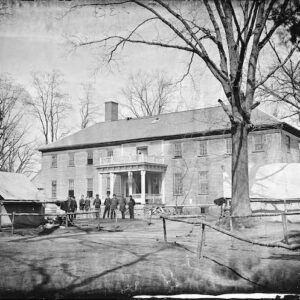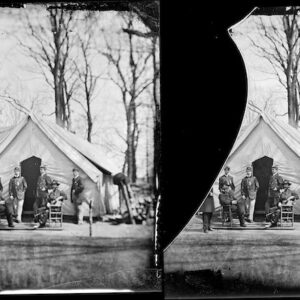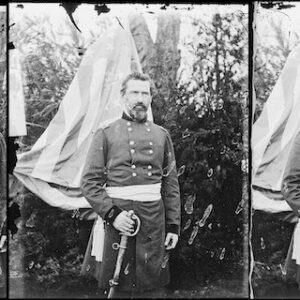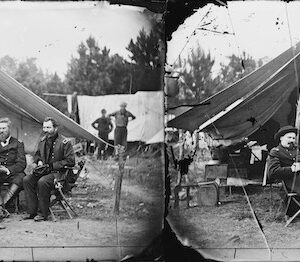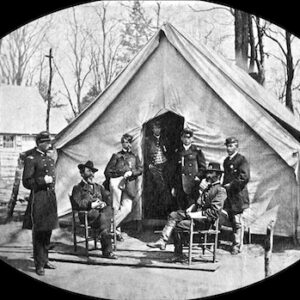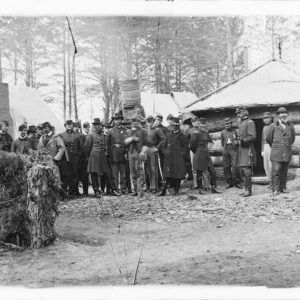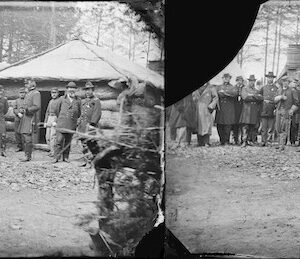Tag: Sedgwick (John)
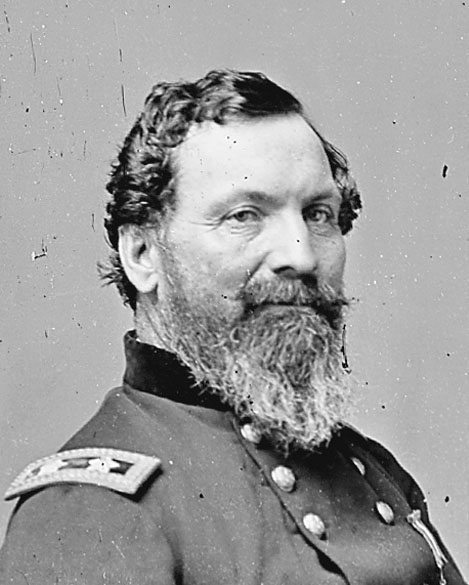 Wikipedia says: John Sedgwick (September 13, 1813 – May 9, 1864) was a teacher, a career military officer, and a Union Army general in the American Civil War. He was wounded three times at the Battle of Antietam while leading his division in an unsuccessful assault, causing him to miss the Battle of Fredericksburg. Under his command, the VI Corps played an important role in the Chancellorsville Campaign by engaging Confederate troops at the Second Battle of Fredericksburg and the Battle of Salem Church. His Corps was the last to arrive at the Battle of Gettysburg, and thus did not see much action. Sedgwick was killed by a sharpshooter at the Battle of Spotsylvania Court House on May 9, 1864, making him and Major General John F. Reynolds (July 1st, 1863 Gettysburg) the highest ranking United States soldiers to be killed in the war. He is well-remembered for his ironic last words: “They couldn’t hit an elephant at this distance.”
Wikipedia says: John Sedgwick (September 13, 1813 – May 9, 1864) was a teacher, a career military officer, and a Union Army general in the American Civil War. He was wounded three times at the Battle of Antietam while leading his division in an unsuccessful assault, causing him to miss the Battle of Fredericksburg. Under his command, the VI Corps played an important role in the Chancellorsville Campaign by engaging Confederate troops at the Second Battle of Fredericksburg and the Battle of Salem Church. His Corps was the last to arrive at the Battle of Gettysburg, and thus did not see much action. Sedgwick was killed by a sharpshooter at the Battle of Spotsylvania Court House on May 9, 1864, making him and Major General John F. Reynolds (July 1st, 1863 Gettysburg) the highest ranking United States soldiers to be killed in the war. He is well-remembered for his ironic last words: “They couldn’t hit an elephant at this distance.”
…At the start of the American Civil War, Sedgwick was serving as a colonel and assistant inspector general of the Military Department of Washington. He missed the early action of the war at the First Battle of Bull Run, recovering from cholera. Promoted to brigadier general on August 31, 1861, he commanded the 2nd brigade of Maj. Gen. Samuel P. Heintzelman’s division in the Army of the Potomac, then his own division, which was designated the 2nd division of the II Corps for the Peninsula Campaign. In Virginia, he fought at Yorktown and Seven Pines. During the Seven Days Battles, Sedgwick’s division fought at Savage’s Station and Glendale, being wounded in the latter engagement. After the Seven Days Battles, he was promoted to major general. The II Corps and Sedgwick’s division were not involved in the Northern Virginia Campaign.
In the Battle of Antietam, II Corps commander Maj. Gen. Edwin V. Sumner impulsively sent Sedgwick’s division in a mass assault without proper reconnaissance. His division was engaged by Confederate forces under Maj. Gen. Thomas J. “Stonewall” Jackson from three sides, was routed, and fell back with barely half the men it had started with. Sedgwick himself was shot three times, in the wrist, leg, and shoulder, and was out of action until after the Battle of Fredericksburg.
From December 26, 1862, he briefly led the II Corps and the IX Corps, and then finally the VI Corps of the Army of the Potomac, which he commanded until his death in 1864. During the Battle of Chancellorsville, his corps faced Fredericksburg in an initial holding action while Maj. Gen. Joseph Hooker’s other four corps maneuvered against Robert E. Lee’s left flank. He was slow to take action, but eventually crossed the Rappahannock River and assaulted Maj. Gen. Jubal Early’s small force on Marye’s Heights on May 3 during the Second Battle of Fredericksburg. Moving west slowly to join forces with Hooker and trap Lee between the halves of the army, he was stopped by elements of Lee’s Second Corps (under Maj. Gen. J.E.B. Stuart, following the wounding of Jackson) at the Battle of Salem Church, forcing his eventual retreat back over the Rappahannock.
At the Battle of Gettysburg, his corps arrived late on July 2, and as a result only a few units were able to take part in the final Union counterattacks in the Wheatfield. It was not kept together as a unit during the second and third days of the battle, its brigades scattered around to plug holes in the line. While much of Sedgwick’s VI Corps was held in reserve at Gettysburg, it performed exceptionally at the Second Battle of Rappahannock Station in November, capturing four field pieces, eight stands of enemy colors and 1,700 prisoners.
Prior to the start of the Overland Campaign in the spring of 1864, George Meade reorganized the Army of the Potomac and dropped several underperforming generals. Sedgwick narrowly missed the chopping block, being that he was unpopular with Secretary of War Edwin Stanton for being a vocal admirer of departed Army of the Potomac commander George McClellan and for having shown insufficient enthusiasm for abolitionism and the Radical Republican platform. Sedgwick had also made enemies among the Radical Republicans by criticizing General Benjamin Butler, one of their favorites. Meade, realizing this, proposed reassigning Sedgwick to command in the Shenandoah Valley. Sedgwick himself acknowledged that he was war-weary by this point and would have welcomed reassignment to a post where not much fighting was expected. In a letter to his sister, he said that he could gladly leave the army without regret and wished to come home to New England. In the end however, General Franz Sigel got the Shenandoah Valley command, which ended up being a much more active theater in 1864 than anyone expected, and Sedgwick remained in command of the VI Corps.
In the Overland Campaign, the VI Corps was on the Union right at the Battle of the Wilderness and defended against assaults by Lt. Gen. Richard S. Ewell’s Second Corps.
Sedgwick died at the beginning of the Battle of Spotsylvania Court House, on May 9, 1864. His corps was probing skirmish lines ahead of the left flank of Confederate defenses and he was directing artillery placements. Confederate sharpshooters were about 1,000 yards (900 m) away, and their shots caused members of his staff and artillerymen to duck for cover. Sedgwick strode around in the open and was quoted as saying, “What? Men dodging this way for single bullets? What will you do when they open fire along the whole line?” Although ashamed, his men continued to flinch and he said, “Why are you dodging like this? They couldn’t hit an elephant at this distance.” Reports that he never finished the sentence are apocryphal, although the line was among his last words. He was shot by a Whitworth rifle moments later under the left eye and mortally wounded. His chief of staff Martin T. McMahon said that the sharpshooters’ bullets were flying all around, making whistling noises, and “The same shrill whistle closing with a dull, heavy stroke interrupted me, and I remember distinctly that I commenced to say ‘General, they are firing explosive bullets.’ when his face turned slowly to me, and blood spurting from his left cheek under the eye in a steady stream, brought to me the first knowledge of our great disaster. He fell in my direction and I was so close to him that my effort to support him failed, and I went to the ground with him.” Corps medical personnel were immediately summoned, but Sedgwick never regained consciousness and continued to bleed out for some time, until his hair was soaked with blood.
Sedgwick was the highest-ranking Union death in the Civil War. Although Major General James B. McPherson was in command of an army at the time of his death and Sedgwick of a corps, Sedgwick had the most senior rank by date of all major generals killed. Upon hearing of his death, Lt. Gen. Ulysses S. Grant, flabbergasted by the news, repeatedly asked, “Is he really dead?”
Showing all 8 results
